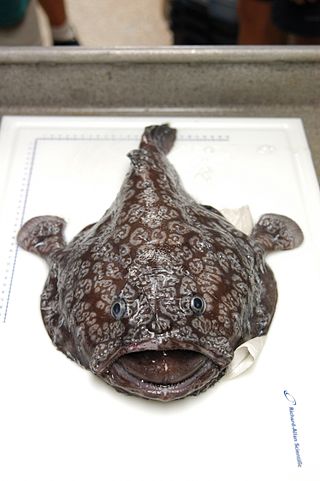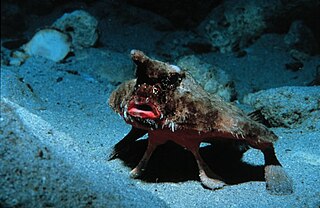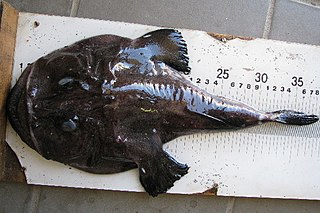
Goosefishes, sometimes called anglers or monkfishes, are a family, the Lophiidae, of marine ray-finned fishes belonging to the order Lophiiformes, the anglerfishes. The family includes 30 recognized species. These fishes are found in all the world's oceans except for the Antarctic Ocean.

Lophius piscatorius, commonly known as the anglerfish, frog fish, fishing frog, monk, European angler, common monkfish, sea devil, or devil fish, is a monkfish in the family Lophiidae. It is found in coastal waters of the northeast Atlantic, from the Barents Sea to the Strait of Gibraltar, the Mediterranean and the Black Sea. Within some of its range, including the Irish Sea, this species comprises a significant commercial fishery.

Members of the genus Lophius, also sometimes called monkfish, fishing-frogs, frog-fish, and sea-devils, are various species of lophiid anglerfishes found in the Atlantic and Indian Oceans. Lophius is known as the "monk" or "monkfish" to the North Sea and North Atlantic fishermen, a name which also belongs to Squatina squatina, the angelshark, a type of shark. The North European species is Lophius piscatorius, and the Mediterranean species is Lophius budegassa.

The footballfish form a family, Himantolophidae, of globose, deep-sea anglerfishes found in tropical and subtropical waters of the Atlantic, Indian, and Pacific Ocean. The family contains 23 species, all of which are classified in a single genus, Himantolophus.

Ceratiidae, the warty sea devils, caruncled seadevils or seadevils, are a family of marine ray-finned fishes belonging to the suborder Ceratioidei, the deep-sea anglerfishes, in the anglerfish order Lophiiformes. The warty sea devils are sexually dimorphic with the small males being obligate sexual parasites of the much larger females. The fishes in this family are widely distributed from polar to tropical seas around the world.

The spotfin frogfish, also known as the big-spot angler, coin-bearing frogfish, darkspot frogfish, ocellated angler, ocellated fringed fishing frog, opulent frogfish, spotfin angler or white-finger anglerfish, is a species ray-finned fish belonging to the family Antennariidae, the frogfishes. The spotfin frogfish is found in scattered locations the eastern Atlantic, Indian and western Pacific Oceans.

The ocellated frogfish is a species of marine ray-finned fish belonging to the family Antennariidae, the frogfishes. This fish is found in the Western Atlantic Ocean.

Glauert's anglerfish is species of marine ray-finned fish belonging to the subfamily Histiophryninae in the family Antennariidae, the frogfishes. This species is the only species in the monospecific genus Allenichthys. This species is endemic to southern Australia.
Lophichthys boschmai, also known as Arafura frogfish or Boschma's frogfish, is a species of anglerfishes closely related to frogfish. L. boschmai is the only species in the Lophichthydae family. L. boschmai were first reported by Marinus Boseman in 1964 to the Rijksmuseum van Natuurlijke Historie, now known as National Museum of Natural History in Leiden. The species was named after Dutch zoologist, Hildbrand Boschma.

Sladenia shaefersi, the Atlantic twospine goosefish or Shaefer's anglerfish, is a species of marine ray-finned fish belonging to the family Lophiidae, the goosefishes, monkfishes and anglers. This species is found in the western Atlantic Ocean.

Ogcocephalus is a genus of marine ray-finned fishes belonging to the family Ogcocephalidae, the deep sea batfishes. The species in this genus are found in the Eastern Pacific Ocean and Western Atlantic Ocean, with most species in the eastern Atlantic Ocean where they live at shallower depths than the other ogcocephalid genera.

Antennarius is a genus of anglerfish belonging to the family Antennariidae, the frogfishes. The fishes in this genus are found in warmer parts of the Atlantic, Indian and Pacific Oceans.

Lophiodes is a genus of marine ray-finned fishes belonging to the family Lophiidae, the goosefishes, monkfishes and anglers. It is one of four extant genera in the family Lophiidae. The fish in this genus are found in the Atlantic, Indian and Pacific Oceans.
Lophiomus is a monospecific genus of marine ray-finned fish belonging to the family, Lophiidae, the goose fishes, monkfishes or anglers. The only species in the genus is Lophiomus setigerus, the blackmouth angler, blackmouth goosefish, broadheaded angler or broadhead goosefish. This fish is found in the Indo-Pacific.

Lophius budegassa, the blackbellied angler or blackbellied monkfish, is a species of marine ray-finned fish belonging to the family Lophiidae, the goosefishes, monkfishes and anglers. This species is found in the eastern Atlantic Ocean and the Mediterranean Sea.

Echinophryne mitchellii, the long-spined frogfish, bristly frogfish, Mitchell's anglerfish, Mitchell's frogfish, prickly angler fish or spinycoat anglerfish, is a species of marine ray-finned fish belonging to the subfamily Histiophryninae in the family Antennariidae, the frogfishes. These fishes are endemic to the temperate waters of southern Australia.

Lophiocharon trisignatus, the spot-tail anglerfish, rough anglerfish or three-spot frogfish, is a species of marine ray-finned fish belonging to the subfamily Histiophryninae in the family Antennariidae, the frogfishes. This fish is found in the Indo-Pacific region.

Ogcocephalus cubifrons, the spotted batfish or polka-dot batfish, is a species of ray-finned fish belonging to the family Ogcocephalidae, the deep sea batfishes. This is an uncommon demersal fish found in the Western Atlantic Ocean and the southern Gulf of Mexico, in the United States, Mexico and the Bahamas.

Lophius vomerinus, the devil anglerfish, Cape monk or Cape monkfish, is a species of marine ray-finned fish belonging to the family Lophiidae, the goosefishes, monkfishes or anglerfishes. This species is endemic to the waters of the southeastern Atlantic and southwestern Indian Oceans around Southern Africa.

Lophiodes mutilus, the smooth angler or smooth monkfish, is a species of marine ray-finned fish belonging to the family Lophiidae, the goosefishes, monkfishes and anglers. This species is found in the Indo-Pacific.


















